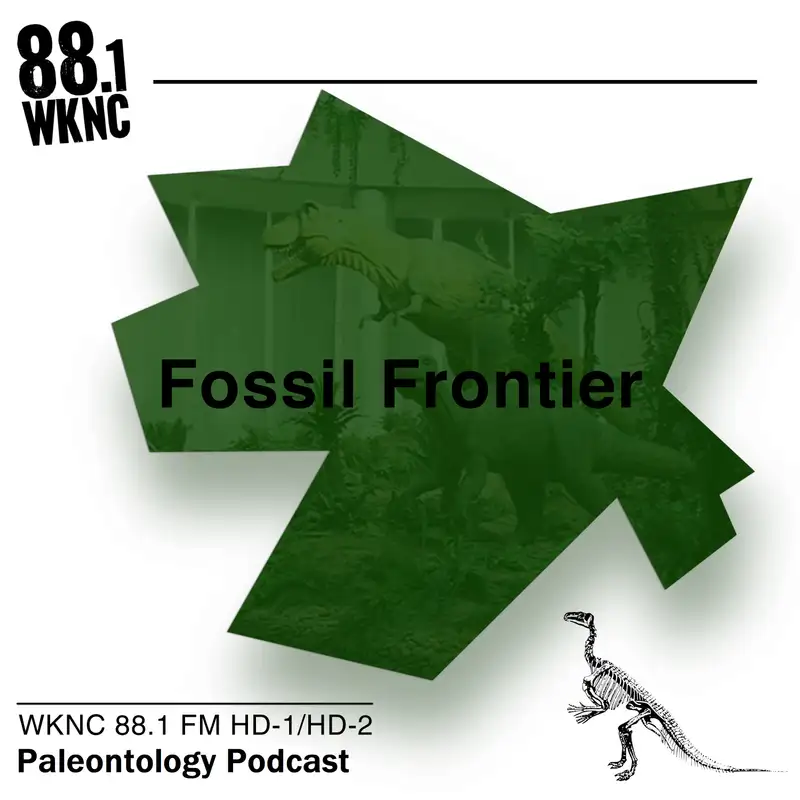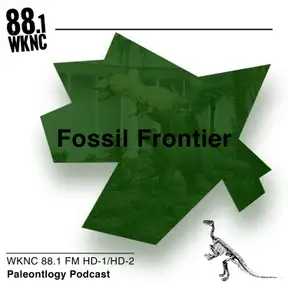Sleeping Dragon: The 3D Dinosaur Fossil
Download MP3Scrimble 0:06
Hello everybody. I'm scrimble and welcome to the third episode of my podcast, fossil frontier, a paleontology podcast brought to you by wknc 88.1 this show will be dedicated to talking about my favorite fossils and prehistoric phenomena. We're going to explore some of Earth's ancient treasures and uncover the stories that they have to tell. So if that's something you're into, you better lock in, because this week we're going to talk about the sleeping dragon. This episode will be kind of different, because I'm only going to cover a single fossil, but the sleeping dragon has captivated paleontologists and fossil enthusiasts alike for years. Okay, So picture this. It's 2011 and Shawn Funk, a miner in Canada, is digging along a cliffside when he hits a mysteriously hard object in the ground. He excavates it, only to find that it's some sort of fossil. We would later discover that this is an 18 foot long, 110 million year old nodosaur, and not just that, but it's also one of the most well preserved specimens found to date. It was so well preserved, in fact, that paleontologists could determine its color, what it ate, and even the weather and natural phenomena of the environment that it used to live in. But I'm getting ahead of myself. Before it was the breathtaking sleeping dragon. It was just a pile of rocks. That was until the specimen was handed over to Mark Mitchell, a paleontologist who spent six years of his life cleaning it off, meticulously protecting its features in great detail, he carefully removed the adhering rock to reveal an almost completely formed nodosaur, which was a type of ankylosaur. The fossil captures the intricate detail of its bony plates, or osteoderms, which are arranged in neat overlapping rows across its armored back as well as its large shoulder spikes. The texture of its skin is so detailed that the nodosaur almost looks like it could spring back to life. The species then received the name borealopelta markmitchelli to commemorate the paleontologist's hard work. The fossil itself is simply breathtaking to look at. I suggest you look it up yourself to fully grasp the detail of the specimen. You see normally when large animals are fossilized, it's only their bones and other hard parts that are preserved. But because of the way this notosaur died and what happened to its body after death, all of its soft parts, including its innards and skin, were preserved as well, giving the fossil the appearance of a sleeping dragon forever protected in stone. But why was this dinosaur different from the others, and how did it get so well preserved? Well, the location where the sleeping dragon was found can actually provide some insight. You see the mine in Canada where it was found is actually right in the middle of what is known as the Clearwater formation. This deposit was formed during the Cretaceous period, when the Mowry Sea ran through the middle of Canada along with the Western interior Seaway, which split North America in half. This is an area rich with fossils of marine reptiles such as the ichthyosaur and plesiosaur. The conditions in this area fostered the development of many well preserved specimens, but none quite as complex and awe inspiring as the sleeping dragon. The interesting thing about this deposit, however, is that it was formed underwater, and the nodosaur was a completely land dwelling dinosaur. So how did this fossil end up upside down at the bottom of the sea, almost 200 miles from shore? Well, paleontologists have theorized that the notosaur first died on land, but then was swept away to sea by a river. It then began decomposing while floating on the Mowry sea. Because these dinosaurs were top heavy. It floated belly up, kept buoyant by the gasses it released while it decayed. Eventually, the body sunk to the bottom of the ocean and rested upside down in the mud. As it continued to release carbon dioxide, the chemical makeup of the surrounding mud changed, and a layer of siderite formed around the body, encasing it in stone and causing a concretion. This is why all parts of the nodosaur were preserved, because it was basically turned to stone deep within the sea. Many small characteristics of the nodosaur are still being studied by scientists today. For example, the pigment remnants in the skin helped scientists deduce that the notosaur had a reddish orange back in a paler stomach when it was alive. This counter shading would have helped the animal deter predators, along with its large shoulder horns and scaly armor. But the most interesting aspect of this fossil is what was found in its stomach. There was a mass of. Matter called a cololite, which is basically just stomach contents. After investigating this cololite, paleontologists discovered that the notosaur ate various leaves and ferns found on land, which reveals that they would have used their narrow snouts to rummage through plants to eat only their favorite leaves. But interestingly, scientists also found the remnants of charcoal in the stomach, likely coming from burnt plant materials. These materials are indicative of a recent wildfire that took place before the notice or died. You see during the Cretaceous period when it lived, oxygen made up a much larger percentage of the atmosphere than it does today, leading to rampant wildfires in North America. After wildfires, ferns are very quick to grow back in the affected area, which is why they were found in the stomach of the nodosaur. It's likely that this dinosaur took advantage of the recently burned area to scavenge for ferns before unfortunately, passing away. Ultimately, this incredible specimen stands as a testament to the marvels of natural preservation, allowing us to peer back through the mists of time with unprecedented clarity. It's a feat of coincidence and luck that this land dwelling Beast was able to drift out to sea to be fossilized in such detail, and as researchers continue to study its remarkably well preserved remains, this fossil promises to unlock further secrets about the ancient world. In this way, the sleeping dragon not only enriches our scientific knowledge, but also deepens our appreciation for the natural world, reminding us of the delicate balance and resilience that continue to shape life on Earth today. Thank you for listening to the fourth episode of fossil frontier. This has been a wknc podcast. Good night, and I love you. The audio use in this podcast was Song Thrush, nature field recording, garden atmo recorded by Garuda 1982 under Creative Commons license.
Transcribed by https://otter.ai

